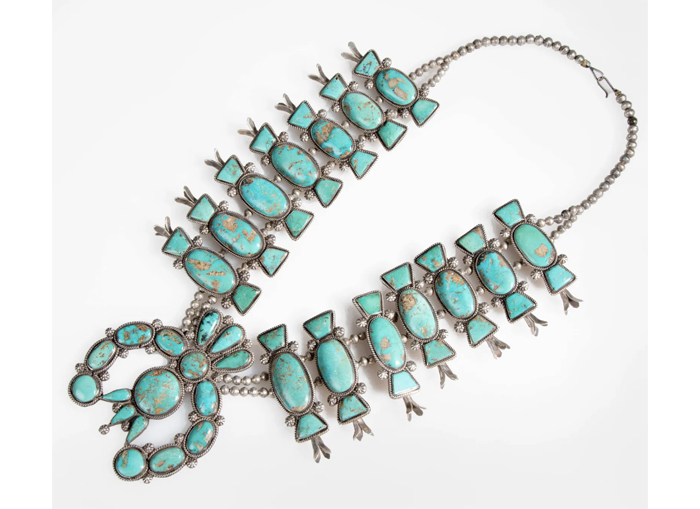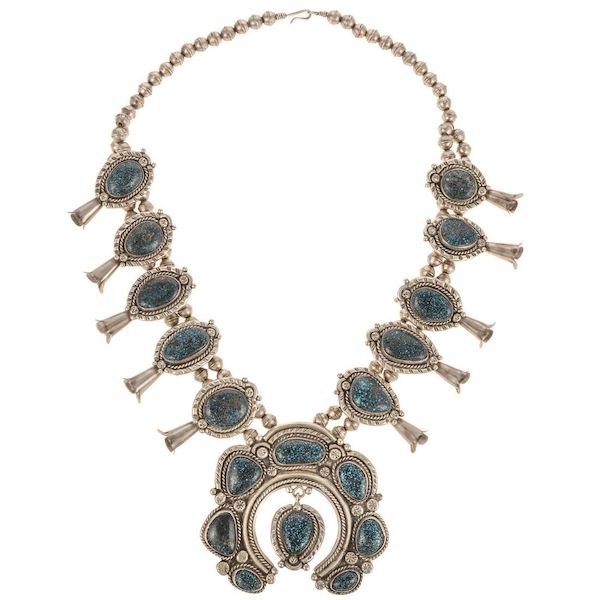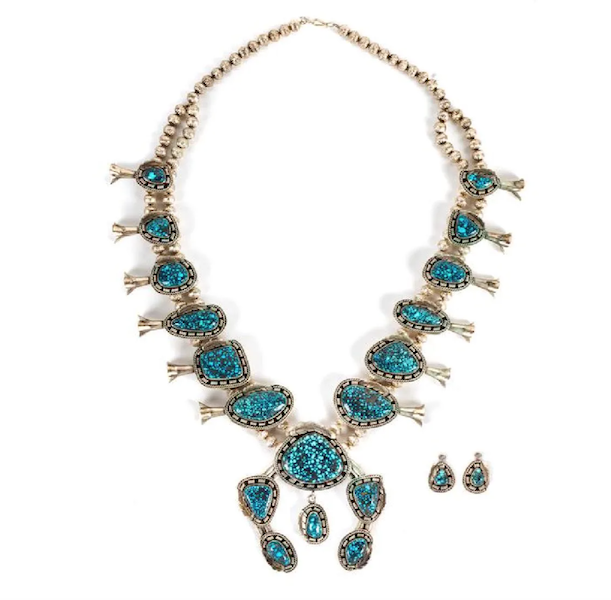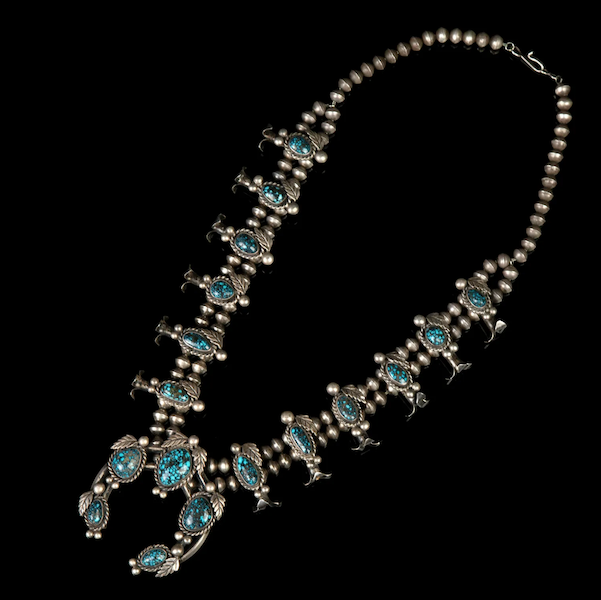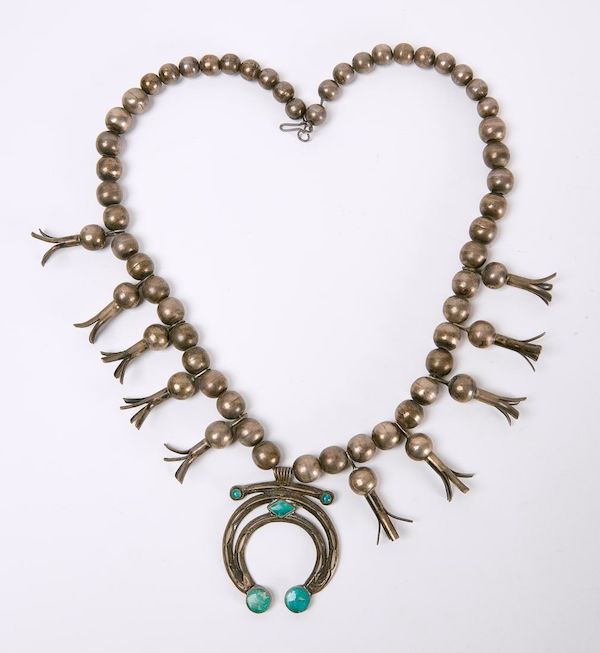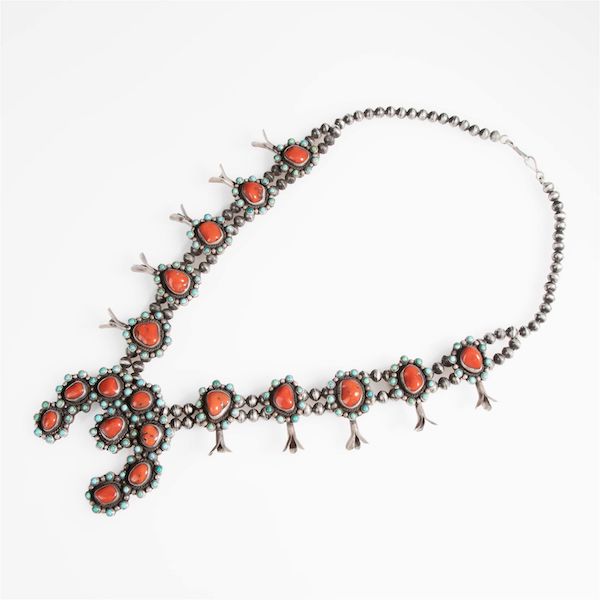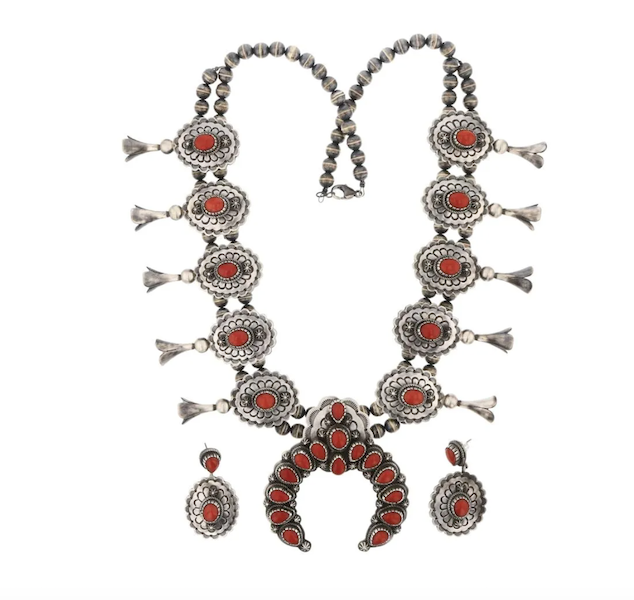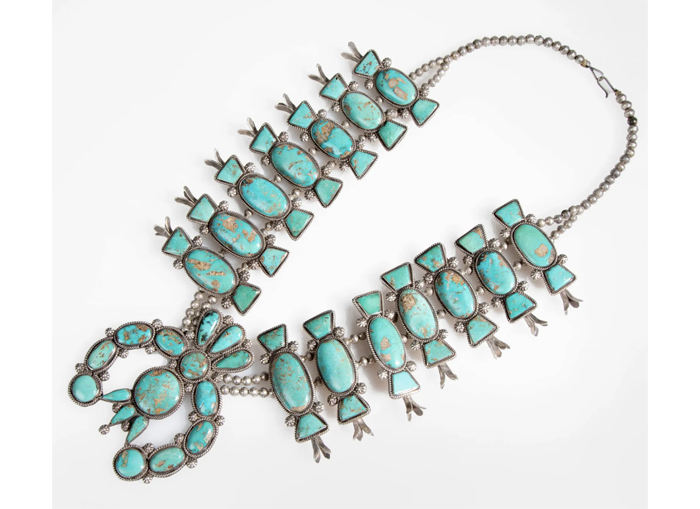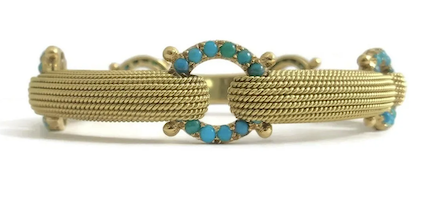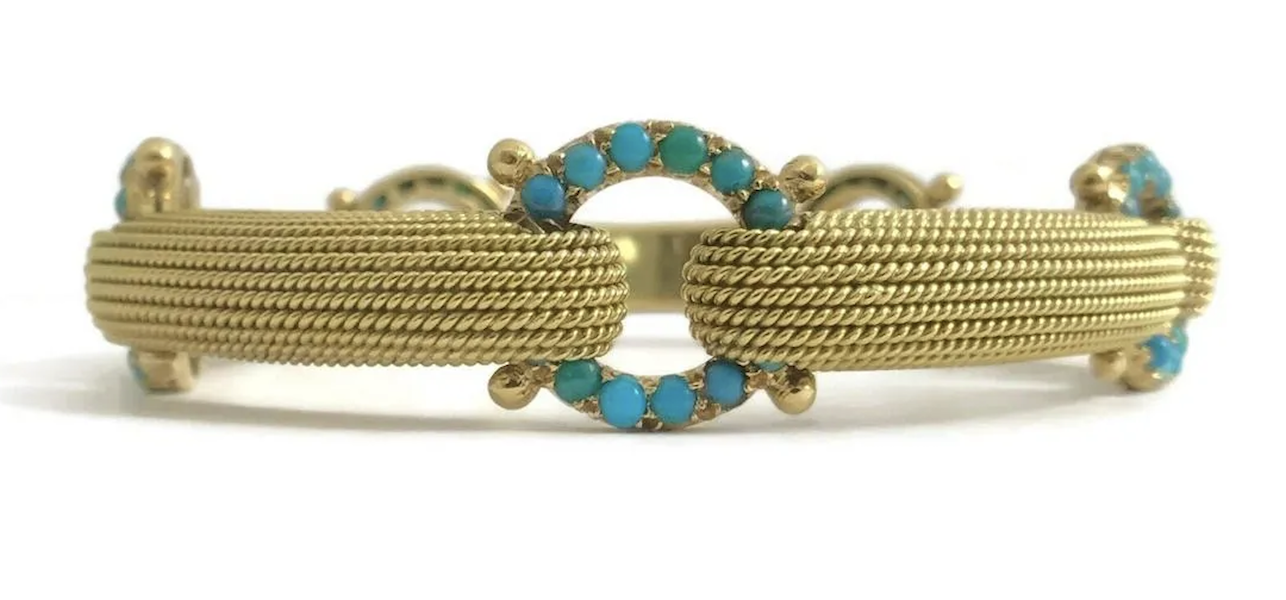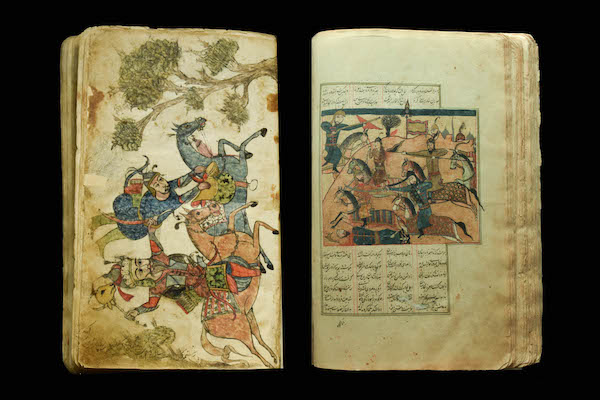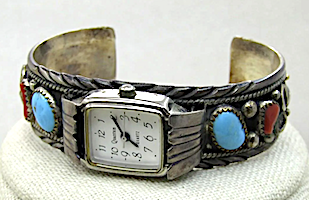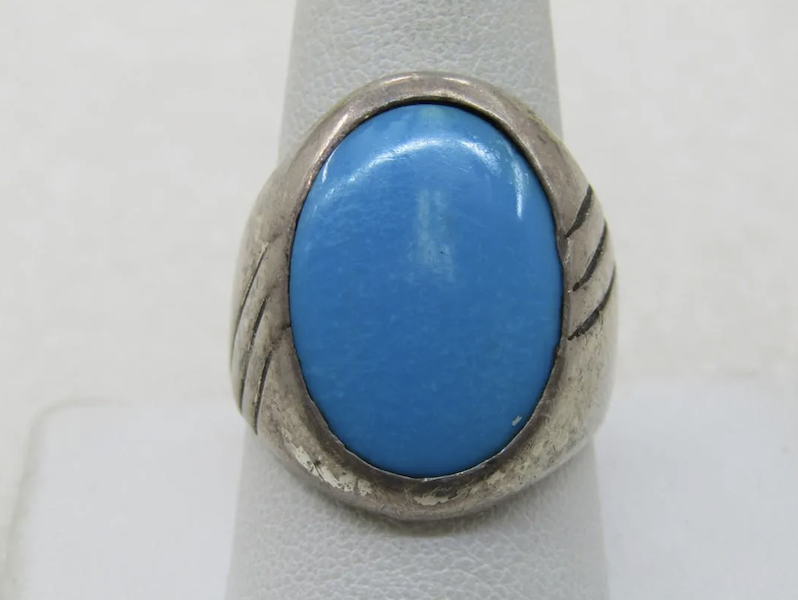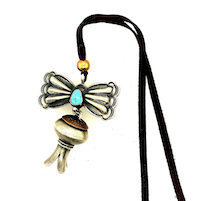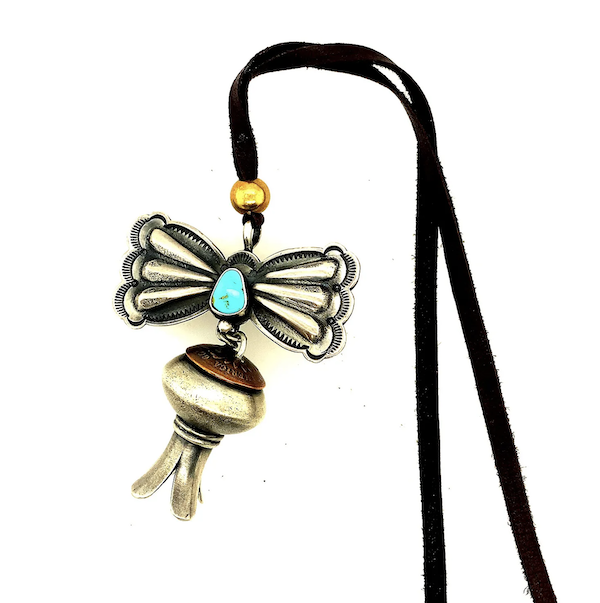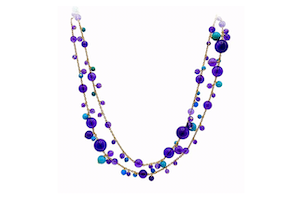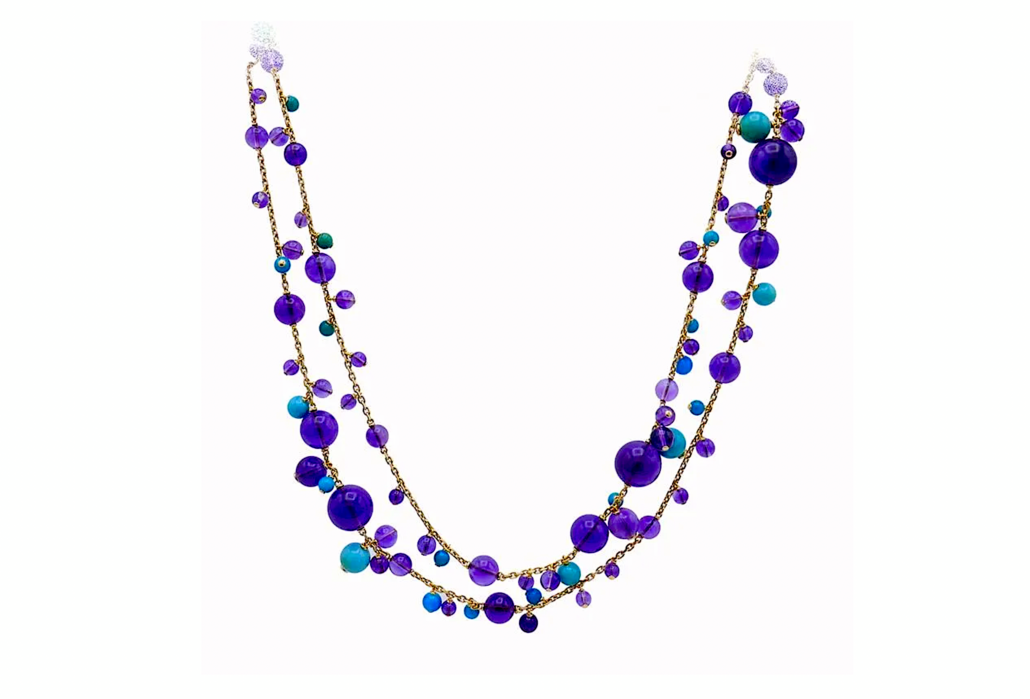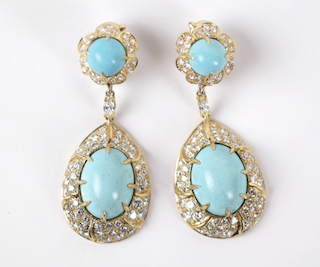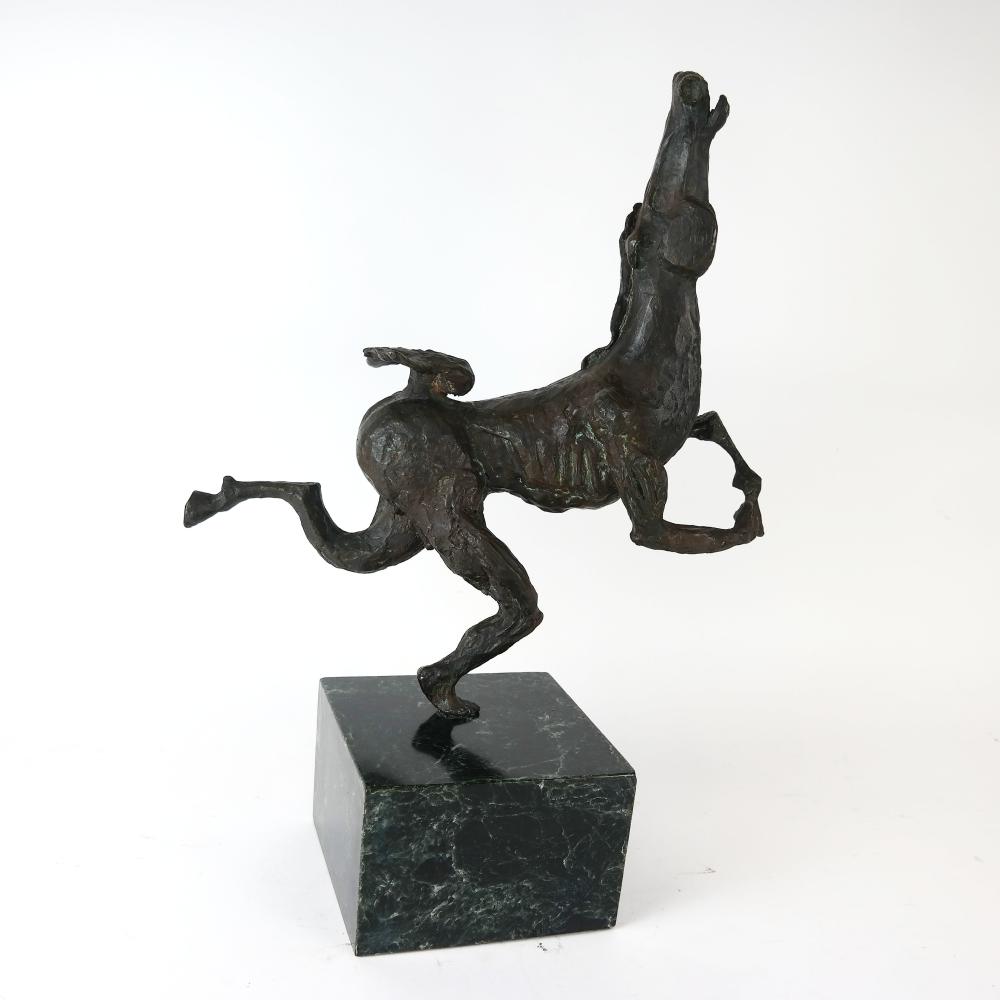NEW YORK — While there is some debate over exactly how squash blossom necklaces got their name, one thing is for certain: they are among the most important forms of Native American jewelry to come out of the American Southwest. Named for the large petal-like stones — typically turquoise — that are set to look like the flowers on a squash plant, these necklaces have three key parts: the gems that comprise the squash blossoms, the smaller round beads surrounding them, and the naja, a horseshoe or crescent-shaped pendant hanging from the bottom.
Much of the appeal of squash blossom necklaces comes from the stones that are used. That definitely was the case with a silver and turquoise squash blossom necklace, likely Navajo in origin, which attained $25,000 plus the buyer’s premium in July 2023 at Alex Cooper Auctioneers. “The turquoise in this necklace is native to the American Southwest region,” said Selden Morgan, director of sales and fine jewelry at Alex Cooper Auctioneers, which has offices in Towson, Maryland and Washington, D.C. “It is exceptional, well matched and rare, a type called spiderweb. The silver is composed of expertly crafted squash blossoms, a traditional bead necklace, fine rope details and naja. It exhibits an exemplary balance between turquoise and traditional silver work.”
Not all turquoise is created equally. It is a rather soft and porous stone that easily chips and cracks, which is why it is often “stabilized” or hardened with other materials, explained Erin Rust, a Native American art specialist at Hindman in Chicago. “However, there is a rather small proportion of turquoise that is considered high-quality gem-grade stones. These stones are harder and more luminous in color,” she said.
Some of the best-regarded examples of turquoise emerged from the Lander Blue Mine in Nevada, which was mined briefly in the 1970s and is believed to have only produced roughly 100 pounds of high-grade material. A piece that might include stones from the mine is a silver squash blossom necklace with 12 blossoms, each with a single high-grade spiderweb turquoise stone and offered with a pair of matching earrings, which earned $13,000 plus the buyer’s premium in May 2019 at Hindman.
“The turquoise is what sets this necklace apart. The stones on this particular necklace have similar characteristics to those of the Lander Blue Mine. The high contrast between the dark ‘spiderweb’ matrix and rich turquoise color is very desirable and only found in a few mines,” Rust said. “Without documentation, we cannot say for sure that the stones in this necklace are Lander. However, the necklace is from the correct period of time. The stones are very high quality, with similar characteristics such as the high luster, depth of color, and webbing matrix, which, in the end, is what drove the price.”
Collectors pounce on necklaces that feature Lander turquoise, such as a circa-1970 Lander turquoise and silver squash blossom necklace attributed to the Diné (Navajo) people that had about 90 carats of the coveted stone. The necklace made $19,000 plus the buyer’s premium at Santa Fe Art Auction in August 2022.
Generally speaking, the three basic attributes Rust looks for in squash blossom necklaces are:
- Age – is the piece an early example from the turn of the previous century, or is it modern?
- Artist – if the piece is a modern example, is it marked or attributed to a specific known artist?
- Stone quality – if there are stones, are they high-grade, gem-quality stones that are neither stabilized nor dyed?
“Quality craftsmanship and well-matched turquoise are highly desirable aspects of a squash blossom necklace,” Morgan said. “Collectors may also consider the size of the naja, the proportions of the necklace, and whether the piece is signed. One with rare, well-matched turquoise in very good condition with well-defined blossoms would be highly collectible.”
According to the website for the Maxwell Museum of Anthropology in Albuquerque, New Mexico, “The history of the origins of squash blossom necklaces is unclear, but they are believed to have been first made in the late 19th century by Native artists.” The naja centerpiece, which is mostly seen as a fertility symbol or used for protection, may have been a North African design that was assimilated by Spanish settlers moving north from Mexico. This form was then exposed to the Southwest peoples. The pomegranate-like shape of the squash blossom design and the horseshoe shape of the naja are both evocative of Spanish culture, which Native peoples often borrowed and interpreted.
Some also say that by the 1870s, Spanish soldiers may have begun trading these necklaces to the Navajo people. They were the first group of Native Americans to begin crafting squash blossom necklaces, and these observers claim that the necklaces represent a blending of Spanish and Native American cultures. The Zuni and Hopi tribal communities are believed to have adopted the necklace design by the 1890s. According to the museum, the earliest examples of squash blossom necklaces were made from silver collected by melting down Spanish or American coins, but later, sheet metal was used in silversmithing.
While squash blossom necklaces don’t appear to have had specific ceremonial uses within Native cultures, they seem to have served as status symbols for those who wore them. The more intricate the necklace, the more valued or important the person was.
Those living beyond the Southwest first became interested in squash blossom necklaces in the late 19th and early 20th centuries, when railroads brought tourist trade to the region. Demand really kicked off in the 1960s when publications and exhibitions brought Native American crafts to a broader audience, Morgan said. The advent of The Institute of American Indian Art in Santa Fe and the Scottsdale Show in Arizona, which both supported and held competitions for artists, caused a production surge.
The appetite for beautiful, thoughtfully designed squash blossom necklaces has yet to abate. A Navajo example with a slightly unusual look made $16,000 plus the buyer’s premium at Jeffrey S. Evans & Associates in June 2022. Set with 18 blossoms, the silver necklace featured a double-form naja that was closed. Buyers evidently liked this style as this piece performed markedly well.
Another interesting take on this classic form was a circa-1940 sterling silver and turquoise box and bow squash blossom necklace, which brought $8,000 at Santa Fe Art Auction in November 2023. The pair of seven turquoise beads running up the sides of the necklace are shaped like bows.
Although most squash blossom necklaces are made with turquoise, this is not always the case. Native American artists have long been interested in coral, and perhaps the best coral in the world comes from the Mediterranean. Squash blossom necklaces that showcase coral typically do not bring as much money as those with turquoise, but they are still cherished by buyers. A Ray Bennett Mediterranean coral squash blossom necklace sold for $6,500 plus the buyer’s premium in November 2021 at Billy The Kid Auction House.
A snapshot of today’s squash blossom necklace market indicates that it is strong and healthy, especially for vintage examples. “From our experience, buyers are willing to pay increasingly higher prices for quality Native American jewelry. The majority of the jewelry we are seeing come onto the market are pieces purchased decades ago in the Southwest, which have been residing in private collections ever since,” Morgan said. “They are becoming available as people downsize and are ready to give their jewelry a new life with a new owner. These pieces are primarily being sought after by American collectors, though there is international interest as well.”
Rust echoed Morgan’s comments, noting,“The auction market for good, high-quality squash blossoms is holding strong and bringing commanding prices. However, I have noticed that the middle- and lower-market pieces have been a little harder of a sell, bringing less than the past few years.”
Morgan said while there are pieces that go for in excess of $20,000, many more are available at prices better suited to beginning collectors, and added, “It is a great time to get into collecting Native American jewelry and craft. The Navajo excel at metalwork and produce many of the quintessentially regarded squash blossom necklaces, but the Zuni are expert carvers of turquoise and furnished the Navajo with many of the stones used in the squash blossom necklaces, as well as crafting beautiful and seemingly delicate pieces of their own.”


